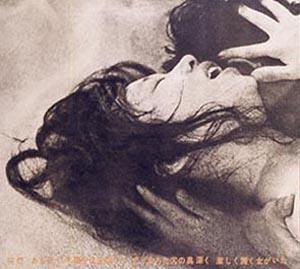Film Review: Woman in the Dunes
The vast sand dunes of Tottori Prefecture, on the Sea of Japan just west of Osaka, provide the setting for this 1964 Hiroshi Teshigahara classic. Adapted from the novel by Kôbô Abe, the film stars Eiji Okada as Niki Jumpei, a high school science teacher and amateur entomoligist. While on vacation from Tokyo to Tottori over a long holiday weekend in search of the elusive tiger beetle, Jumpei misses the last bus back to town and must find lodgings for the night. The locals are all too happy to escort him to the home of a young widow who sometimes takes in travelers. It's already dark when they arrive, and Jumpei is surprised when they instruct him to use a rope ladder to climb down into a sand pit, where he finds the widow waiting for him in a rustic beach house.
She makes him welcome with a hot meal and a bath, but her hospitality is marred by the constant trickle of sand through the cracks in the roof, which has formed a layer of grit on every horizontal surface. In the middle of the night, long after Jumpei has gone to bed, he is awakened by the sound the widow shoveling sand into large metal bins, which the locals will haul up with a pulley, and sell to building contractors. The widow explains to Jumpei that she must toil away like Sisyphus at this nocturnal task, lest the sand engulf her house by morning. So Jumpei helps her shovel sand. But the next morning, when he is ready to depart, he finds the widow, sleeping naked, covered with a fine layer of sand, and the rope ladder is nowhere to be found. Like the unwitting prey of an antlion, Jumpei is trapped.
In the first few weeks of his captivity, after first demanding, then begging the locals to release him, Jumpei becomes more creative in his efforts to escape. He ties up the widow to keep her from shoveling. He envisions revitalizing Tottori as a tourist attraction. He brainstorms ideas for agriculture, like tulips and peanuts, which will both grow in sand. He threatens to tear the house apart to build a ladder. He forms a makeshift grappling hook and braids a cloth rope in hopes of climbing out. He even tries to trap a crow to use as a messenger for an S.O.S. All to no avail.
Over time, Jumpei settles into the widow's routine, sleeping by day, shoveling sand by night, eagerly awaiting the weekly rations of food, water, whiskey, and cigarettes, which arrive by pulley, wrapped in a newspaper. As the seasons come and go, Jumpei comes to know the widow, beginning with the obvious question: Why doesn't she just let the sand engulf her house and walk away. To which she replies that her husband and daughter were buried there by a sandstorm, and she knows no other way of life. "If it weren't for the sand, no one would even bother about me."
But as one might expect, Jumpei and the widow share more than conversation in their sandy confines. Nature takes its course, and when the widow becomes pregnant and begins to suffer complications, it seems that Jumpei may finally get his chance to escape from this tender trap.
For all its stark simplicity, Woman in the Dunes is an existential masterpiece. The search for meaning within the archetypal struggle of Man versus Man, Man versus Nature, and Man versus Himself, is revealed through potent symbolism, illuminated by transcendent black-and-white cinematography that captures in micro-detail the textures and contours of this strangely sandy and forbidding world. And the provocative juxtaposition of a dutiful widow resigned to her fate, and an unrelenting scientist with a gnawing desire to leave his name in the history books, ultimately shows that hope springs eternal from even the most barren landscape.
 ThingsAsian
ThingsAsian















